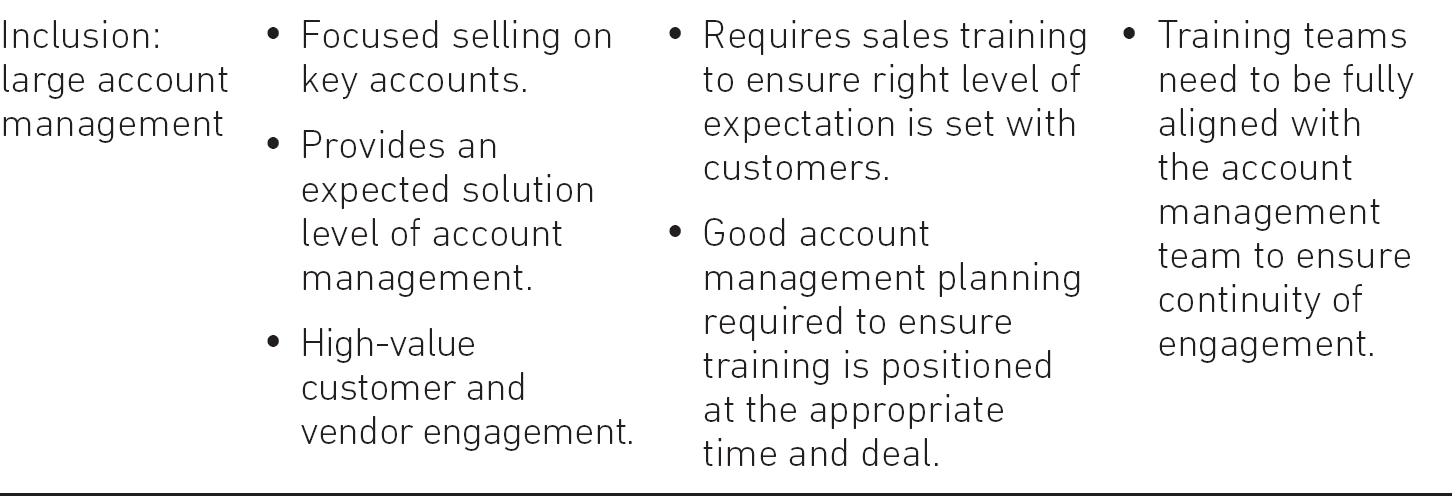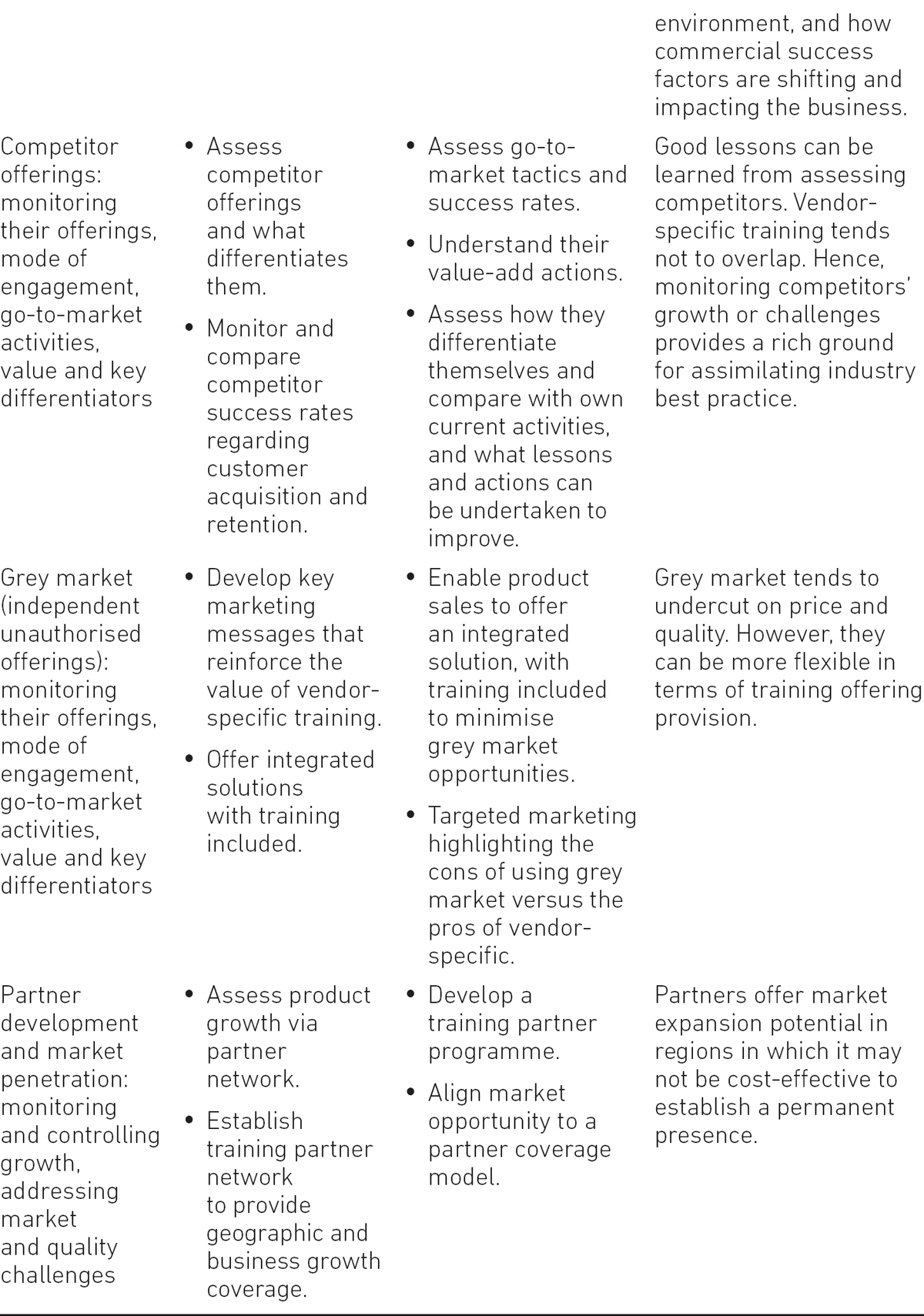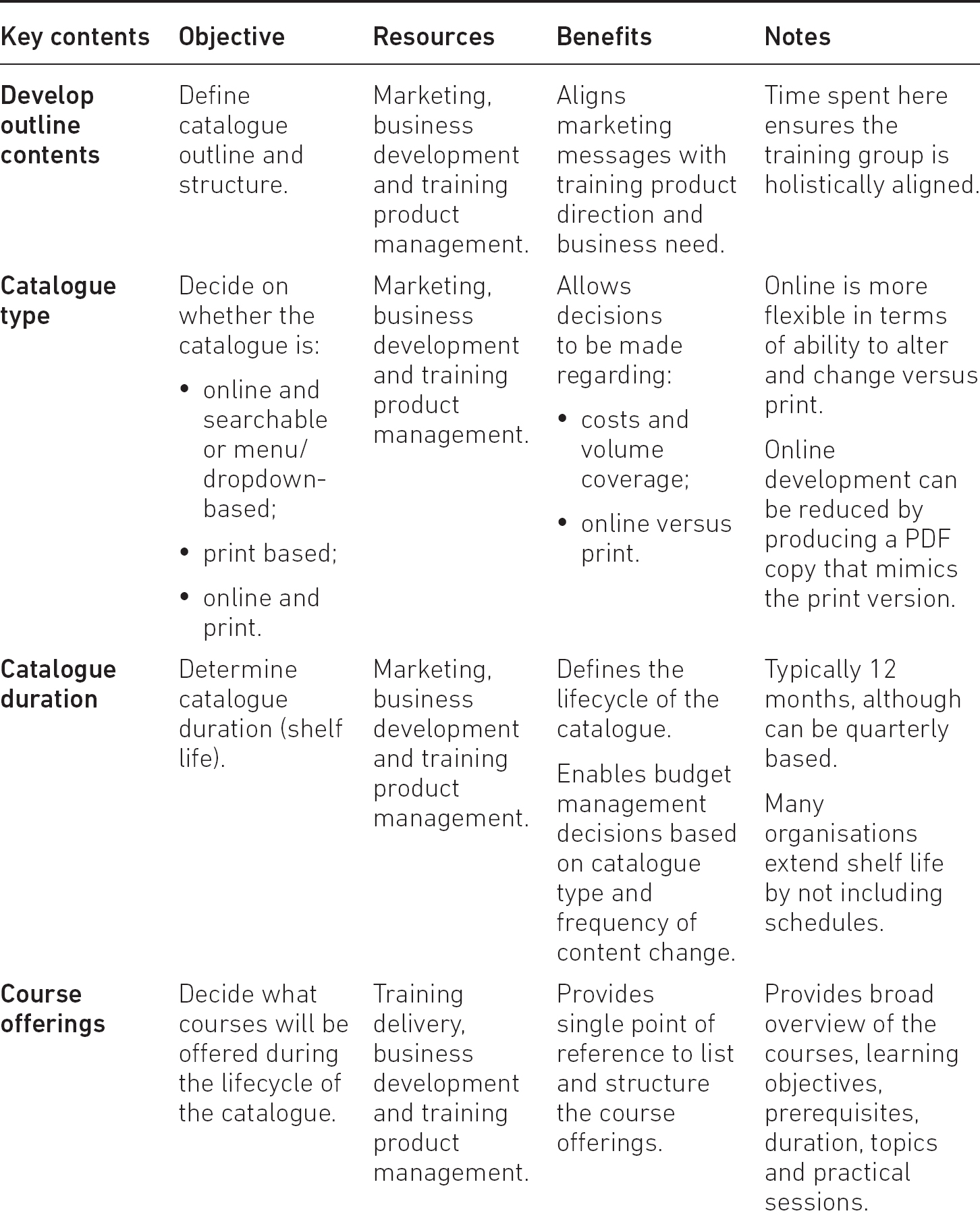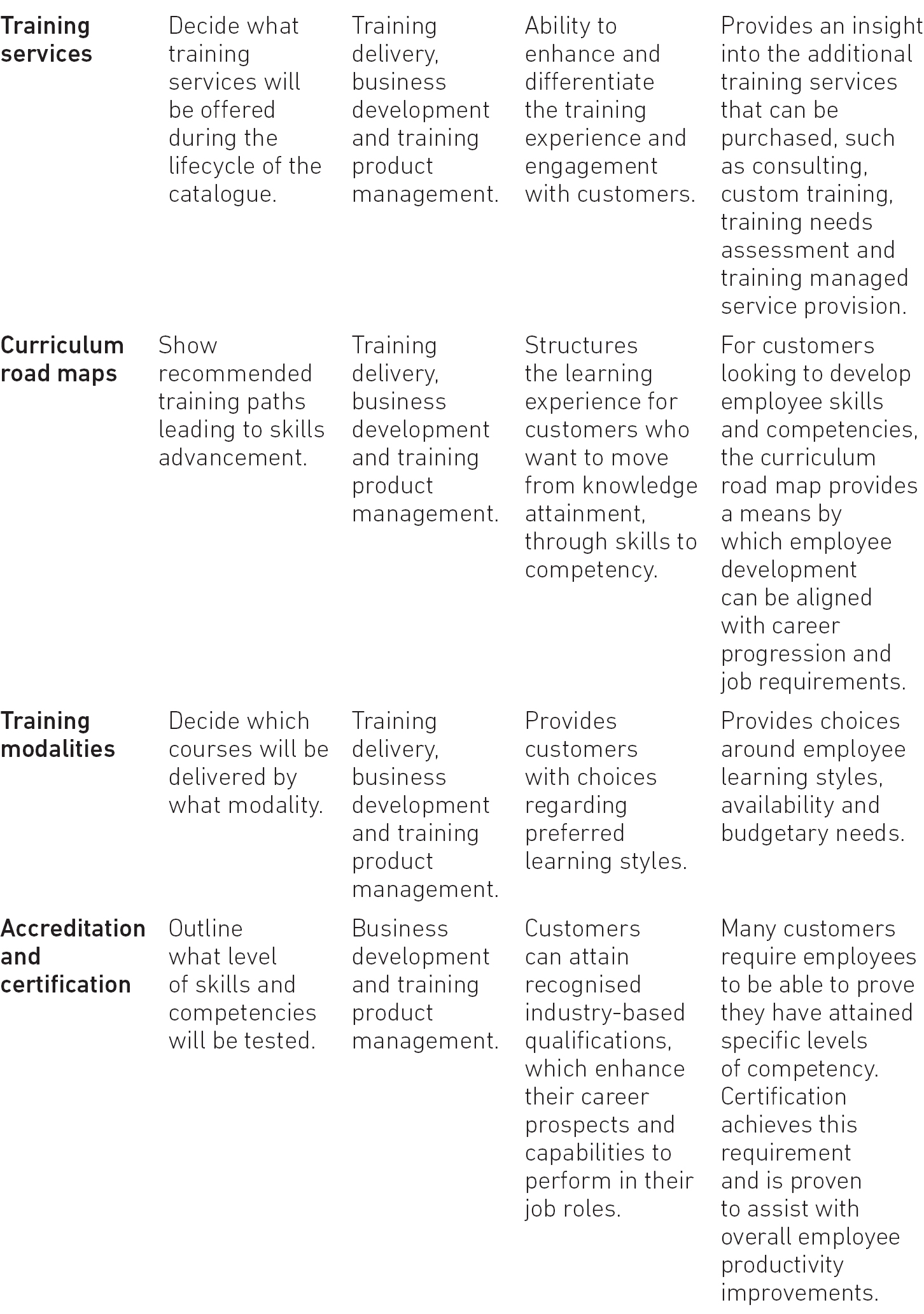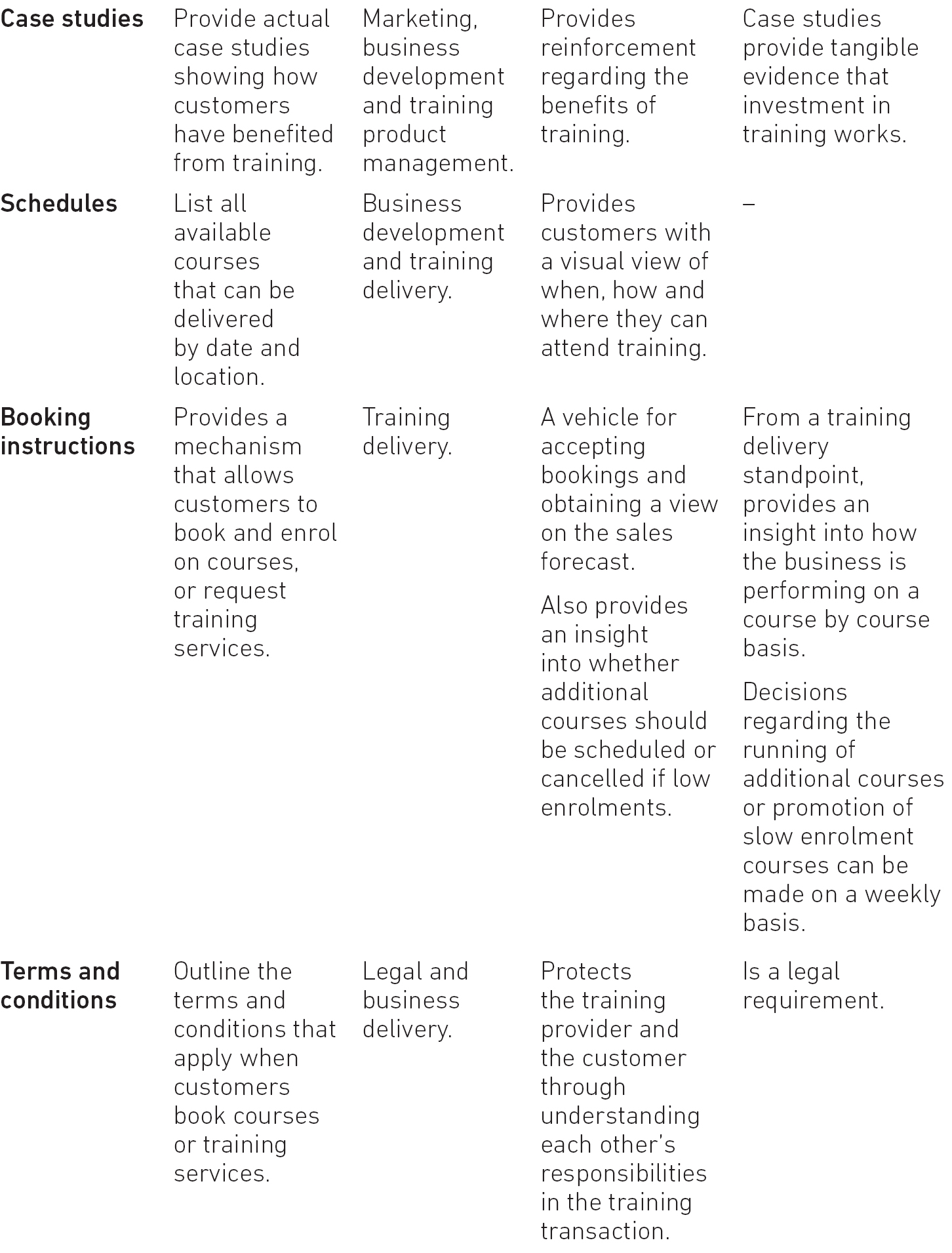5 BUSINESS DEVELOPMENT AND MARKETING MANAGEMENT
Building a training business and managing its success
Establishing, growing and maintaining a training business as it moves forward requires strong skills in business development and awareness of marketing management.
This chapter looks at the roles and responsibilities of a business development manager (BDM) in terms of the activities required to develop and grow the business in line with the agreed strategy.
Sales and marketing components of business development are also covered. The sales element covers discount policies, vendor specific objective evidence (VSOE), attach rates, and competitive and tactical strategies. The marketing element covers demand and lead generation, promotional materials and the implementation of customer, advisory and reference programmes.
As new technologies enter the training sphere, they have the potential to influence the way in which organisations gain a competitive edge through disruptive business growth. This is briefly discussed at the end of this chapter.
Sales and business development are often considered to be one and the same in terms of selling an offering to a customer. The reality is that they are different: sales provide the connection between an organisation and its customers regarding the positioning, presenting and selling of training, whereas business development refers to activities based on expanding the training organisation’s reach into new and existing markets – for example, forming partnerships with other businesses to sell or include offerings that complement each other or provide greater market reach and sales coverage.
The BDM role is a combination of quality management, strategic analysis, marketing management and sales. The objective is to identify new business opportunities, expand market share and develop partnerships to generate new and increased revenue.
Building a training business requires the BDM to actively engage specialists to assist in establishing, growing and maintaining the business as it moves forward. The BDM also needs to have strong skills and awareness of market management. This involves expanding the customer base, maintaining influence and awareness, improving customer opinions of the training offerings, and raising the company’s overall perceived value in the eyes of the customer. Marketing management can sometimes be overlooked or lack investment when comparing the training contribution to overall company product or service offerings.
BDMs need to justify and show the value of marketing management or risk the challenge of failure and ineffectiveness.
To win in the training business, the training offering, along with the sales and marketing effort, needs to be relevant and effective. Without engaging the market, it simply will not happen!
BUILDING SUCCESSFUL VALUE PROPOSITIONS
Value propositions are used by companies to summarise to potential customers why they should purchase a product or service such as training. They should be clear and concise in terms of explaining how training would address a customer’s issue of concern, the benefit it provides and why it is a better solution than other competitors’ solutions.
If a customer’s training needs cannot be explained quickly or succinctly, then it is not a value proposition. Without a need, there is no incentive for customers to engage or purchase. The key to building successful value propositions is to:
- relate to the needs of the customer;
- outline how the training offering stands out from others;
- provide evidence that the deliverable will meet the customer’s need.
The two example value propositions shown below highlight the need to develop a solution to address the specific opportunity. The first example is based on a training group’s generic view, and the second based on a specific customer need.
- Training group view: Maximise customer skills and their return on investment in our technologies by providing high-quality and relevant technical training aligned to the achievement of their required business outcomes, while differentiating the learning experience through task-based rather than role-based training provision.
- Specific customer need: To protect your corporate environment against cyber-attacks, by investing in our cyber-security technology, we propose to align the required training based on assessing employee risks, vulnerabilities and exposure to the security challenges facing your organisation. With our security implementation teams working together, we will be in a strong position to develop employee competencies and confidence via a combined and aligned training solution.
Both are value proposition statements. The first is stating at a high level the rationale and value the training group brings internally and externally when undertaking an initial sales pitch. The second is more specific to the actual customer need and minimises the detail required later within a sales proposal.
DISCOUNT POLICY IMPLEMENTATION
Within any organisation there will be different and varying views on discount policy implementation. For example, finance will argue that while the opportunity for winning a deal is maximised, the margin contribution is minimised. However, the head of sales will fight for discounts to win against competitive forces.
At the end of the day, the training business unit owner will need to sign off on the discount policy a BDM is proposing, while simultaneously recognising that the role of the BDM is to ensure the right tools are in place to gain and maintain market traction. Discounts are part of the marketing tool set and can be very effective if used and applied correctly. To achieve correct application of a proposed discount policy, it needs to be defined, monitored and administered. Table 5.1 highlights the objectives, benefits, shortfalls and considerations of applying discounts in the world of training.
Table 5.1 Discount policies (factors for consideration)

VENDOR-SPECIFIC OBJECTIVE EVIDENCE (VSOE)1
Generally Accepted Accounting Principles, also called GAAP or US GAAP, are formal principles adopted by the United States Securities and Exchange Commission (US SEC).
As part of these accounting practices, VSOE is a method of revenue recognition. VSOE is intended for use by US-based companies to maintain GAAP compliance with the American Institute of Certified Public Accountants (AICPA). Any US subsidiary operating outside the USA must support and report VSOE. UK and European companies do not have to follow VSOE.
VSOE enables companies to recognise revenue on specific items included within a multi-item sale, based on evidence (specific to the company) that the product has been delivered.
The purpose of GAAP is to ensure that financial reports reflect earnings in the period they were delivered. For example, a company selling a solution comprising software, installation and a one-year training contract can only record the overall sale on a deferred basis, with earnings being recognised over the term of the training contract. However, based on VSOE, allocation occurs by splitting the revenue among the products and related elements, which is the price established by the vendor for the separate sale of each element, allowing them to recognise the individual revenue components at their respective delivery stage. This allows companies that sell items comprising software licences, training contracts and hardware items to recognise the revenue of the hardware items on delivery, with the software licence and training contract being recognised at the time of their individual fulfilment.
VSOE revenue recognition is commonly used by companies that sell software products and services in multiple-element bundles. VSOE focuses on the fair market value of an item sold individually, as opposed to the assigned sales value of the item sold as part of a multiple-element bundle.
From a training perspective, it is common practice to maintain the overall average price charged to customers, irrespective of how the product is bought (bundled, discounted), to within 15 per cent of list price, to satisfy and justify VSOE fair pricing assessments. Note that VSOE interpretation varies by company, so it is important to discuss this aspect with the finance department to get a definitive answer.2
CARVE OUTS, ATTACH AND INCLUSION RATE STRATEGIES
Maximising training revenue by leveraging product sales teams can be challenging and also rewarding. It can be challenging when looking to encourage them to include training within the sales process. It is rewarding when they apply one of three strategies, namely Carve outs, Attach or Inclusion to include training within their customer engagement and resultant sale.
Carve outs
If a sales person sells an IT software solution to a customer at an all-inclusive price, it is up to the training team to request a percentage of the deal to be allocated to the department; this is known as carve out. Initially, this seems a good opportunity for the training department to ensure revenue flow; however, the reality in many instances is that the accounting department cannot recognise the revenue without applying VSOE principles and obtaining agreement from the product sales teams that the product revenue is lower than the full amount charged.
Carve outs are not popular or welcomed in many organisations but often requested by sales representatives who are eager to close deals without building the cost of training into the overall sales price. It can be viewed as a form of discount that is beneficial to the customer but detrimental to the overall true value being sold by the vendor.
Problems can arise with this type of sales approach in respect of VSOE implications, booking and revenue recognition, and sales and delivery compensation.
From a training perspective, carve outs offer a way of ensuring training is included seamlessly within most sales transactions. The downside is overall company revenue is reduced and, unless the business unit training manager is particularly savvy, no revenue is recorded as training and delivery costs have to be absorbed. The golden rule, therefore, is to gain corporate agreement on any carve out strategy regarding booking and revenue allocation.
Attach rate
Training attach rate strategies, whereby sales teams automatically include training in the sales discussion and as a fully priced offering, should be the norm in any product- and service-based business. In many companies, product support or maintenance is attached, but for some reason this is not always the case with technical training.
The challenge is often around positioning the value, not just to the customer but to the organisation at large. Many surveys over the years have shown that customers are more inclined to purchase training if positioned at the initial point of sale. For a customer to invest and allocate a budget for buying a product only to find after the sale has been concluded that they then need to invest in training is ludicrous. The result is loss of trust and a customer now looking to locate the training at the cheapest cost possible.
Time spent by the BDM and training business owner with sales, marketing and product management leaders is crucial, especially regarding new product releases. Customers purchase business outcomes, not functions and features. As with all business outcomes, there are three components: technology, process and people. All these are important and entwined, so training should be part of the overall solution being sold.
Whether BDMs can sell an integral solution or a combined package, attach rate strategies are important tools in their arsenal. Attach rates are typically defined as a percentage of product sales or deals. For example:
- training revenue as a percentage of product (that is, £50,000 training with £1,500,000 product sales would be a 3.3% attach rate);
- assessing the number of training deals to overall product deals (that is, 500 training deals versus 5,000 product deals can be classified as either an attach rate or inclusion rate of 10%).
Inclusion rate
Attach rates tend to be revenue-based which is a measure of training revenue sold versus product revenue sold, whereas the inclusion rate is a measure of the number of deals that have been included with a sale.
Within the software industry, a 2 per cent attach rate is deemed typical, if not disappointing revenue-wise. However, if an inclusion rate of 10 per cent was achieved, this would be much healthier. Revenue attach can be misleading as large amounts of revenue may have come in from a small number of deals, whereas inclusion highlights the percentage of customers including training within a broader vendor solution.
Adopting inclusion over attach is a matter of choice; certainly, the ability to influence customers in the short and longer term is more effective with the inclusion strategy. Whichever one is favoured, Table 5.2 summarises some of the strategies that could be adopted.
Table 5.2 Attach and inclusion strategies
COMPETITIVE AND TACTICAL STRATEGIES
BDMs need to be fully aware of the competitive forces affecting the success of the training business as well as the tactical actions required to implement and ensure any challenges or growth opportunities are exploited accordingly.
Competitive strategies can take many forms, as shown in Table 5.3. Also shown in the table are corresponding tactical strategies and key activities that BDMs can implement to stay ahead.
Table 5.3 Competitive and tactical strategies
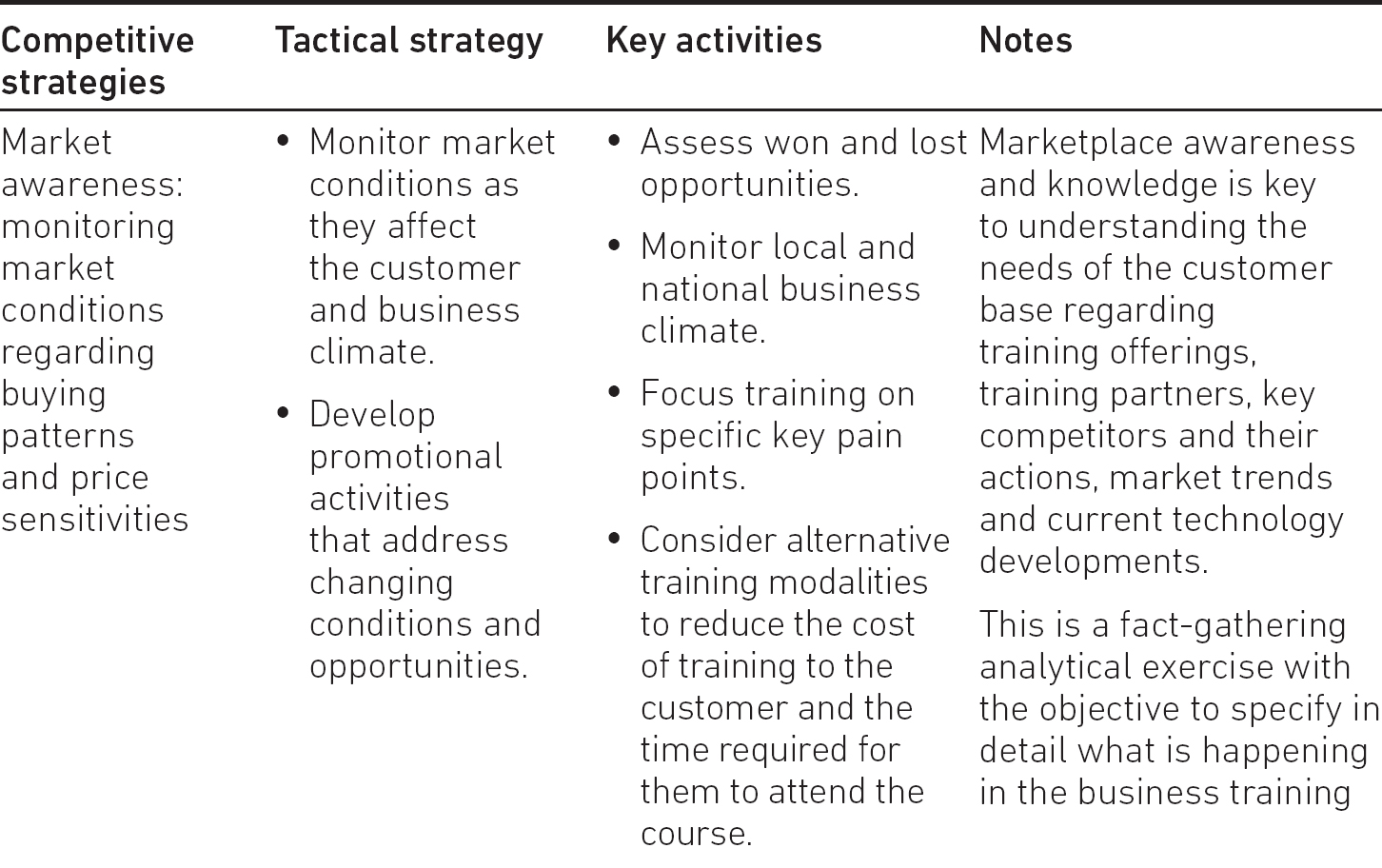
As explained earlier in this chapter, business development covers many aspects, from the right market offerings and discount policies to competitive strategies. All are important and very much entwined.
Another key area is that of demand and lead generation. However, an issue that often arises is understanding the difference between lead generation and demand generation, which are quite often used interchangeably, but are very different.
When allocating budgets to these types of marketing activities, it is important to know which one does what and how their value is measured:
- Demand generation is focused on shaping the target audience perspective on what they should consider buying and, hence, is measured in terms of bookings or revenue generated.
- Lead generation is focused on capturing customer information, which can then be used to drive demand via well-crafted messages and campaigns; typically measured in terms of the percentage of leads that led to revenue generation opportunities.
It is certainly not possible to have one without the other. From a vendor training perspective, lead generation can be eased by referencing and using product-based customer information and accessing customers who have support contracts, which can then be targeted with relevant demand generation campaigns.
Demand generation
For demand generation to be effective, the requirement is to have a clear view of the characteristics of the target customer and their buying process and to build a content framework by which to launch targeted messages.
The most crucial of these is knowing the customer characteristics. Without this, it will not be possible to decide:
- on what marketing message content is to be created;
- what tone, style and delivery vehicle is required;
- what training topics and targets to focus on to develop and grow the business;
- who within the target audience needs to be focused on and why.
To understand the training buyer characteristics, the BDM should organise a series of meetings between marketing, training sales and the delivery teams. This is important as all groups can share their unique insights on the customer rather than generating a biased and skewed one, which can result in an incorrect and invalid view. From these discussions, the buying groups can be structured around job function (such as training management, buyer, end user, system designer) rather than job title (such as vice president, director).
The next stage is the customer buying process and understanding and identifying the specific decisions or steps the training buyer goes through. Typically, this stage is asking what motivates them to start looking for a training solution. Often, this can be answered by assessing how the BDM’s own company positions the product and what importance they place on the business outcome. From this data point, it becomes possible to determine and analyse further how the buyer progresses through to making a purchase.
Demand generation normally fails when not enough objective research has been undertaken. By working closely with product sales, the value of training can be positioned and investigated via the use of customer focus groups.
The next stage is to develop a content framework. The framework uses the output from the previous stages to assist in developing the message to be used to drive demand based on valid justifications. The content framework is based on building a matrix using the buyer characteristics and the collected buying process information, and asks the following questions:
- What are training buyers asking?
- What response should be provided?
- Which communication vehicle should be used to reply?
- What customer behaviour is expected from the responses?
A typical content framework could look like Table 5.4.
Based on the agreed framework and required customer behaviours, business development and marketing can construct a series of targeted demand generation campaigns. These types of activity take between two to three months when working across a large corporation or one to two months for a medium-sized company.
Lead generation
Lead generation is a marketing activity used to generate interest in training. The leads themselves are then passed to sales for the purpose of developing a sales pipeline. Obtaining the leads can be undertaken using various methods and approaches.
Advertising and emailing customers, which used to be the norm, is no longer an efficient way to establish and maintain an ongoing meaningful relationship. With the increasing use and interest in social media networks (LinkedIn, Instagram, Facebook, etc.) and subscription-based communication channels such as YouTube, and in some instances the training organisation’s own website, a stronger and more relevant relationship can now be developed and matured.
When training buyers undertake their own research for information on courses and training products without engaging in conversation with a sales person, there is a requirement to establish a strong and relevant digital presence. Attracting attention and, more importantly, maintaining it, especially with respect to training, requires the provider to become a trusted advisor by publishing and creating valuable content assets and thought leadership.
Table 5.4 Demand generation content framework
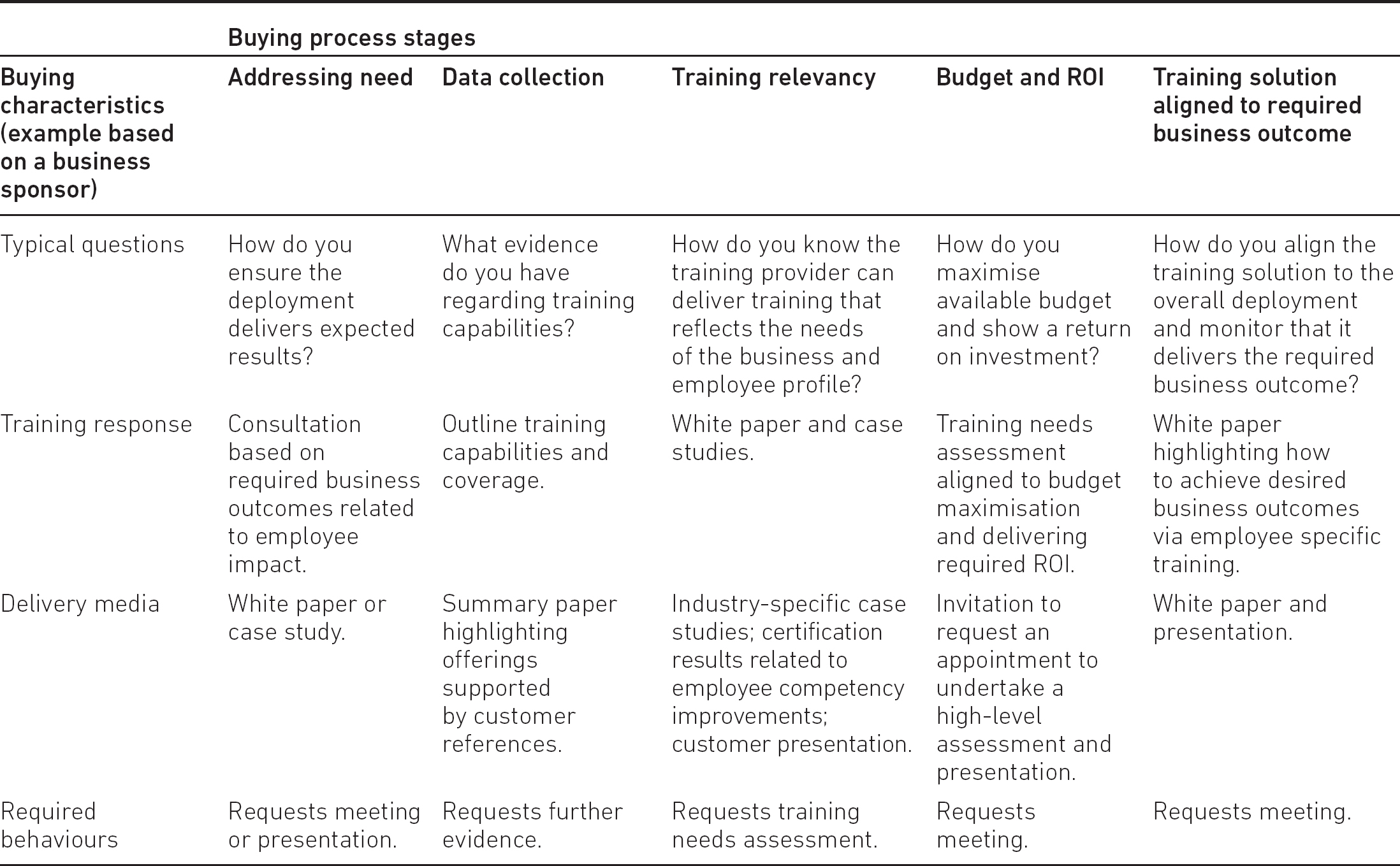
Other marketing techniques still apply, but it is important to prioritise these in relation to marketplace need and current lead marketing trends being deployed. Lead generation can be deemed to be inbound or outbound. Both are relevant and need to be considered as part of a broader training marketing strategy. Tables 5.5 and 5.6 highlight the differences between the two.
Table 5.5 Inbound lead generation matrix
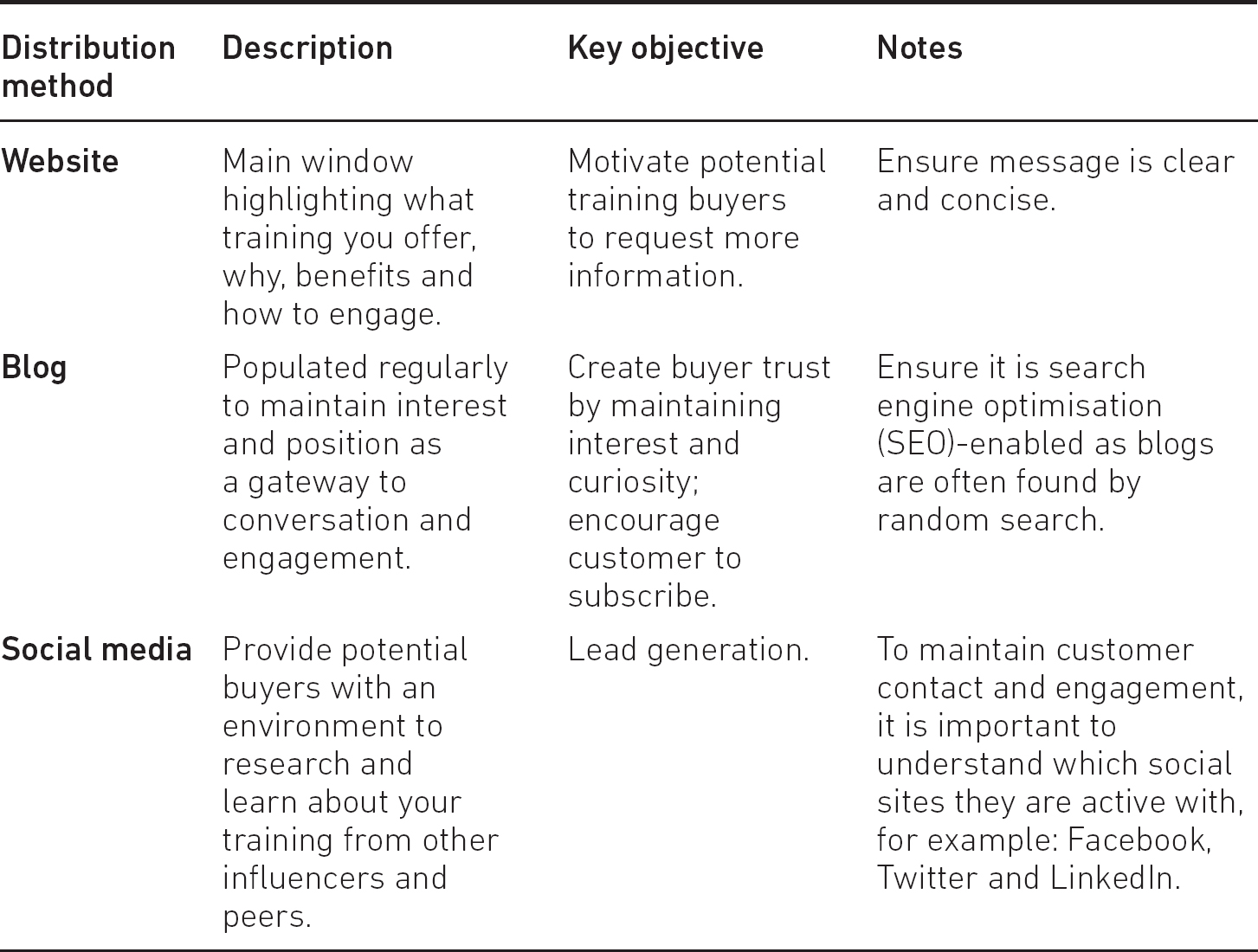
Inbound marketing is about helping customers to find and be aware of the training group before they are seeking to buy training. Then progress them towards being a valid lead and ultimately becoming a training revenue stream.
The important point to remember in relation to the use of the internet is to focus on quality not quantity, and, particularly, useful reference-based material which helps SEO tools to be more effective.
From the broader training marketing strategy point of view, inbound lead generation activates broad interest, whereas outbound lead generation allows the acceleration of inbound efforts and targets specific opportunities.
Using outbound channels enables the introduction of key messages and content to potential prospects. To be effective, outbound lead generation is normally highly targeted, with a call-to-action that is obvious. This effectively means that well-focused outbound marketing can encourage potential buyers to move closer to being ready to buy training offerings.
Table 5.6 Outbound lead generation matrix
Irrespective of the depth, level and nature of lead generation adopted and implemented, it is vital metrics for success are clearly defined, measured and analysed. Without this the training budget will be scrutinised and reduced, which in turn minimises the ability to justify investment in the short and longer term. Common lead generation metrics that companies use include those shown in Table 5.7.
Table 5.7 Common lead generation metrics
Lead generation metric |
Description |
|
Marketing effectiveness in terms of its contribution to the overall sales pipeline |
Measurement of potential training revenue contributing to the sales pipeline process as a consequence of marketing lead generation activities. |
|
Marketing effectiveness in terms of generated revenue |
Measurement of training revenue generated in relation to deals obtained as a consequence of marketing lead generation activities. |
|
Number of valid qualified leads |
Number of valid leads generated by marketing, as confirmed by the training sales team. Often reported as a percentage of the total number of leads provided. |
|
Cost per lead |
Total campaign costs/quantity of leads. |
As noted in the previous section on demand and lead generation, the use of digital techniques is of course standard practice. The important point with any form of marketing, and, in particular, the internet, is the need to focus on quality not quantity. The main objective is to attract, acquire and engage a clearly defined and understood target audience. Understanding the various options, their benefits and their shortfalls, is vital to ensure marketing investment is not wasted.
SEO
SEO is an important component in the use of digital marketing. Without it, content may well go unseen. Its main function is to expand visibility in generic search engine results, improve rankings and drive customer traffic.
There are many elements to SEO, from words on a page to the way other sites link to a specific website. SEO can simply be a matter of making sure the website is structured in a manner that search engines understand.
With the majority of internet traffic being serviced by the commercial search engines of Google, Bing and Yahoo, if the big three can’t locate the training content then in the majority of instances it will go unnoticed. The use of social media sites can generate training website visits, but search engines are the primary means by which target audiences will navigate the web.
Push and pull digital marketing
Digital marketing can be very effective in promoting training as long as the principle of using ‘push’ (email) and ‘pull’ (pay per click, website presence, etc.) technologies to execute a marketing programme is understood. Its success is based on considering the following requirements:
- it must be targeted;
- it needs to be trackable;
- it has to be measurable;
- it involves the development of a relationship with the interested customer requiring training.
Table 5.8 summarises the main digital marketing methods currently in use, along with their chief requirements and the potential benefits to be gained.
Table 5.8 Digital marketing methods
Promotional material provided to potential customers should be a quick summary and reinforcement of what they actually require.
Leaving them with a company mug helps to keep the name alive, as does a USB stick. From a product perspective, it is about creating brand awareness and brand loyalty. From a training department perspective, the promotional value is low. Reinforcing the company name does not provide any meaningful engagement, whereas fact sheets, course outlines and catalogues provide data that can be used and referenced and form a component part of demand generation. When considering the use of promotional products, the following guidelines apply:
- Promotional materials should be part of an overall promotion plan.
- Leverage corporate marketing and media activities where possible.
- Select an effective promotional product in terms of the overall contribution it will make to brand awareness, and what key objectives it is looking to achieve.
- Use a relevant promotional product that tempts the potential customer and provides some form of intrigue, not just for them, but others around them. T-shirts are good for this when used with quirky messages.
- Understand the what, the why and the cost/return; this is crucial, including its contribution to the overall marketing plan.
Time spent on defining the promotion plan, with the ability to include ad hoc promotional activities, is key. As is the need to explain in detail the required costs and expected revenue returns, especially if funding is required from corporate, as opposed to local, training department funding.
Apart from mugs, T-shirts and USB memory sticks, typical training promotional examples include fact sheets and catalogues.
Fact sheets
These are typically one to two sheets of information highlighting key training points with supporting data. The layout is often stylised and contains training course or offering information, technical data, answers to common questions and contact information.
Catalogues
Sometimes referred to as a training brochure, a catalogue is arguably the most important promotional aid available, highlighting the range of technical training courses and offerings provided.
For many influencers or purchasers of training, this document provides a professional insight into how the training is delivered, what course offerings and services are provided, purchasing options, recommendations for developing employee skills and competencies, and, very importantly, the training group’s values.
Most training providers send an electronic copy to their customer base and print a smaller batch for use by sales personnel and for supporting targeted promotional activity. Table 5.9 summarises the key steps that should be followed in order to develop and produce a training catalogue.
Table 5.9 Course catalogue key summary steps
Course outlines are an important part of the promotion process (see a sample in Figure 5.1), allowing influencers, buyers and training managers to gain an insight into how the learning process will occur and its relevance to their specific needs.
In some instances, this can lead to requests for customisation of content, which opens up broader customer opportunities. It is potentially one of the most important promotional assets to assist in closing out the final stage of lead generation or influencing a final purchase. Table 5.10 summarises the essential elements that should be considered for inclusion when producing a course outline.
Table 5.10 Course outline key elements

Course schedules
Customers often search online for course offerings they are interested in. The next stage in the sales process is to close the sale with a definite booking date. This is where the course schedule comes into its own. Typically, it lists the courses on offer, available dates, locations and price in local currency.
Course schedules assist in generating demand and progressing revenue. However, care needs to be taken not to damage brand reputation and customer confidence if the schedules offered cannot be delivered or have to be cancelled. It is important to put in place a course schedule that reflects the actual demand in the marketplace. See the example given in Figure 5.2.

MARKETING, PUBLIC RELATIONS AND PROMOTIONAL EVENTS
Marketing is a broad discipline covering direct marketing, advertising and promotional activities to drive and encourage interest in purchasing training. Public relations (PR), on the other hand, is focused on managing a training group’s reputation by generating positive media coverage.
Marketing
Marketing covers a wide range of activities to ensure that the needs of the training customer continue to be met and to encourage positive interaction. Marketing in general tends to be fairly standard in its approach; where it differs in execution is around the nature of the offering. For example, marketing instructor-led training versus eLearning will be very different because the buying characteristics, needs and availability are not the same. In fact, positioning one against the other is not a good approach. In training, it is all about providing value decision-based choices. It is encouraging the customer to view training as a requirement that can be consumed to satisfy a variety of variables and needs; for example, learning preferences and maximising use of their available budget. What is important is knowing the customer and aligning them with what can be offered, rather than setting the wrong expectations.
As previously covered in this chapter, demand and lead generation play a role within the marketing function and part of these activities can lead to an understanding of broader opportunities or risks. These can be further explored in terms of investigating new training products or services, price points and what the competition is providing. Depending upon the structure of their training marketing department, some vendors place this activity under corporate product management (see Chapter 3) or as part of the training group, sometimes under the curriculum development umbrella.
PR
Public relations covers ongoing activities to ensure training has a strong public image. In reality, this resides at the corporate level, which requires training management to be well versed in broader company messages in order to assess how best to entwine the training offerings into the broader PR activity.
PR is often conducted through the media by way of press releases via trade magazines and sponsored events.
Promotional events
Promotional events can comprise invites to attend a 1–2-hour introductory training session, dialling in to a virtual seminar, or part of a broader company-wide promotional activity. They can be used to launch a new training curriculum or offering in order to generate interest and awareness in the market in support of a product that is due for release.
For an event to be successful, it is important to understand what the goals are, how success is measured and what the target market is. For example, in supporting a new product release, the training department might want to raise awareness among customers who are early adopters of the technology about the level and nature of the training and how it would assist them to capitalise on the new technology. The goals are usually around raising awareness to drive attendance and bookings on the new training curriculum. Success could be measured in terms of the number of advanced bookings made within the target market of early adopters.
Promotional events can be costly to organise, and it is important to assess the financial returns and risks before undertaking them.
CUSTOMER AND TRAINING PARTNER ADVISORY MEETINGS
In order for the training business development and marketing teams to expand the group’s reach into new and existing markets, it is an advantage to obtain the views of current customers and training partners. One way of achieving this is to establish customer and partner advisory meetings.
Customer advisory meetings
Customer advisory meetings (CAM) can be productive for both parties. For customers, it provides an opportunity to share ideas among themselves and to advise the training team on their needs, concerns and observations. For the training team, it provides legitimacy in probing for market intelligence and positioning new offerings with a view to obtaining a candid response in a safe environment.
In order for the CAM to succeed, and be seen as a good use of valuable time, the meetings need to encourage active participation both during and in between the sessions. It is important to maintain momentum between meetings if customer involvement is not going to ebb and flow in terms of interest and activity.
To initiate and maintain a CAM, the recommendations shown in Table 5.11 should be considered. By implementing these actions, there is a better chance of ensuring ongoing participation and active engagement. This in turn validates the investment and should provide good ongoing value and insight into what customers require and need in a trusted commercial partnership.
Training partner advisory meetings
Training partners face many challenges: constant changes in technology and delivery models, dealing with business model transitions and maintaining profit margin contributions. By establishing a training partner advisory council (TPAC), the training business development and marketing teams can both obtain an insight into how best to represent and address the broader interests of this community.
The process and approach are similar to that of the customer advisory meetings. The key consideration in setting up a TPAC is to ensure that it represents all partners around the geographic area of operation and covers a cross section of partner types from small through to multinational organisations.
Table 5.11 Customer advisory meeting recommendations

Customer reference programmes help to enhance sales and marketing activities and support active demand generation. Customer testimonials influence and encourage buyers to proceed further in their decision making by explaining how a real solution solved their training need. Tangible and demonstrable results are a sales person’s dream for training!
Customer reference programmes should be centrally managed to ensure sales and marketing know where to go in order to maximise their effectiveness. With training often being side-lined in larger organisations, a library of training case studies that can be referenced helps to validate and legitimise the importance and contribution of having training included in a broader product sales offering.
One final note is do not over demand requests on any one customer as it can quickly undo long earned relationships.
Table 5.12 highlights some best practices that should be considered when introducing a training-related customer reference programme.
Table 5.12 Customer reference programme best practice summary
Any form of innovation that creates a new market and value proposition, be it product, service or business execution, will be disruptive by nature. When it is implemented, it initially tends to be a slow burner and then expand rapidly, often leaving the competition well behind.
Technical training is no different. Harvard, MIT and Stanford universities introduced massive open online courses (MOOCs) that provided content for free and tuition for a fee, which rapidly undermined the smaller colleges (Selingo 2014).
The Council for Adult and Experiential Learning (CAEL) proposed that what someone has actually learned in the execution of their job is far more important than time spent sitting in a classroom, which led to the introduction of prior learning assessments (PLAs) allowing employees with experience to get recognition without attending a training course (www.cael.org/). This in itself led to the concept of badges as a way of building credentials over time rather than attending a series of courses followed by certification.
The same is true regarding the selling of training. While transactional single course selling is lucrative and highly contributive to the bottom line, subscription-based selling offers cost-effectiveness to the customer and long-term committed revenues for the training provider. In a competitive environment, this can be disruptive in terms of forcing a change in the training delivery and a change in how revenue is recognised.
The old adage of investing a little to learn a lot holds true when contemplating disruptive business growth. Basically, it is about not being complacent and instead focusing on improving existing core training business. By allocating a small amount of money and time, good progress can be made in initiating innovative and effective disruption.
Business development and marketing management are key components in establishing, growing and maintaining the training business as it moves forward.
On the business development side, consideration has to be given to competitive and tactical strategies, which in turn need to be supported with documented policies and guidelines such as discount management, attach rate objectives and adherence to VSOE or equivalent requirements.
Marketing needs to assist growth in providing demand and lead generation to enable sales to develop a pipeline of revenue opportunities and indirect promotional and influential activities via customer, advisory and reference programmes to maintain ongoing market interest.
The business development manager’s (BDM’s) main objective is to identify new business opportunities, expand market share and develop partnerships to generate new and increased revenue opportunities.
Defining value propositions assists in demonstrating to potential customers why they should purchase training, which helps to minimise the risk of a no sale.
To ensure a training group maximises its revenue opportunity, clear expectations regarding allowable discounts and how revenue will be best attained via attach or inclusion rates needs to be defined and agreed. As does the expectation on marketing to drive demand via well-crafted messages and campaigns, typically measured in terms of the percentage of leads that result in sales-based revenue generation opportunities.
As digital marketing techniques are standard practice, the importance of SEO to expand visibility in search engine results is fundamental to driving customer-related traffic to engage with the training organisation.
Promotional materials, whether digital or paper-based, provide quick summaries and reinforcement of what a customer actually requires by way of facts sheets, catalogues and course schedules.
Through the use of customer and partner advisory meetings, the training business development and marketing teams can both gain insights into new and existing markets that can be used to their advantage.
Opportunities to be disruptive for positive business growth should not be ignored but, equally, should be given careful consideration before implementing if the organisation is seeking to gain competitive commercial advantage.
1 Content provided by Wikipedia under the Creative Commons Attribution-ShareAlike License.
2 Content provided by Everipedia under the Creative Commons Attribution-ShareAlike License.
3 Computer Education Management Association (CEdMA) Europe Ltd would like to thank ServiceNow for allowing the use of the Project Portfolio Management Fundamentals course outline.



